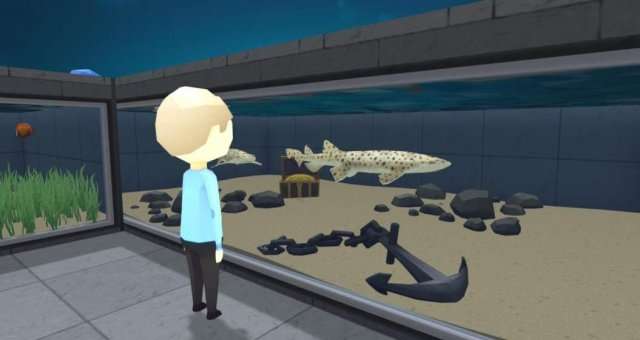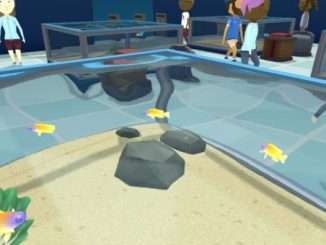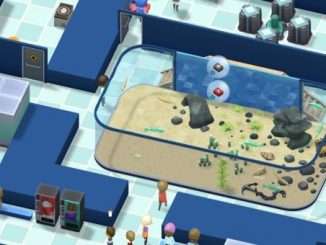
Auto-feeders: if you’re playing through the campaign, you never see them until the final level and then suddenly you need to use them to beat it. But how do they work, exactly? I did some investigation and wrote this guide covering what I’ve learned.
The Basics of Feeding
All credit goes to Philadelphus!
Auto-feeders are an interesting piece of equipment in Megaquarium, but before we talk about Auto-feeders, let’s talk about…
Feeding
Like I imagine a lot of people did, I learned to play Megaquarium by playing through the campaign. Over the course of the campaign, I learned a lot of things, but not much about feeding other than that my staff took care of it for me (if they had the skill, were allowed to, and were assigned to the right regions).
In Megaquarium, staff can carry up to 50 units of one type of food at the same time. At lower ranks, this is typically massive overkill—early fish are small and eat only a few units of food each, and with small tanks it’s nearly impossible to reach a requirement of more than 50 units of a single food type per tank per day. Thus, for a long time you don’t need to worry about feeding, masking this important aspect of gameplay.
Eventually, however, you’ll have enough large animals in a tank to push their combined food requirements for one type of food above 50 units. Then what happens? Staff will bring 50 units of food, then go back and pick up another 50 units of food, feed the animals again, and repeat until all animals are fed or you run out of that particular kind of food in your aquarium for the day.
(For the curious, food doesn’t seem to get split up among animals; instead, it’s a sort of first-come first-serve system which works down the line according the order animals are displayed in the tank. Suppose you have three fish in a tank that each eat 30 units of food. A staff person comes, bringing 50 units. The first fish gets 30 units and is fully fed. The second gets 20 units, and remains hungry. And the third gets nothing! If uncaught, this could lead to weird situations where one fish dies of hunger while the rest appear perfectly well-fed.
Auto-Feeders: How Do They Work?
So how do auto-feeders relate to feeding? Well, the basic thing to keep in mind is that an Auto-feeder acts like a single staff feeding. Let’s go over the stats:

Auto-feeders are found in the Special Equipment section upon researching them at Rank 12. They cost $1,000, have a fairly poor reliability of 85, and are very high skill to repair. They cannot dispense Supplement, and can only feed animals that do not require any degree of skill to feed.
Auto-feeders much be attached directly to a tank (so no using pumps), and must have one of their three remaining sides accessible to staff for maintenance. For deep tanks, auto-feeders will require a platform of the correct height next to them to be able to access them (no accessing them from the ground).
Once you’ve got your auto-feeder in place, you can select a type of food from the types present in the game: orange pellets, green pellets, mussels, cockles, zoo plankton, sand eel, sponge pellet, artemia, herring, krill, crab, live lug worms, or live mysis shrimp. Once you’ve selected one, they will continue to provide an infinite amount of that food without needing to restocked by staff (though they will cost money whenever they refill automatically, like normal food storage containers do).

Each day, at the start of the day, an auto-feeder will:
- Fill itself up to its maximum capacity of 50 units of the selected food, then.
- Immediately dispense food into its attached tank sufficient to meet the needs of the consumers of that food in that tank, up to the full 50 units it contains. Some animals don’t eat every day, in which case if no other animal in the tank requires the food it dispenses it will simply fill itself up without dispensing any food.
The food dispensed acts exactly like a single staff feeding using that food. If the combined demand for that food in the tank is more than 50, the food will be distributed as specified in the section on the basics of feeding.
Multiple auto-feeders can stack if there is sufficient demand. Two auto-feeders can dispense up to 100 food units of a single type, three can dispense up to 150, etc. Multiple auto-feeders with different kinds of food can also be attached to a tank, subject only the normal constraints of space.
Mods: Large Auto-Feeders
There’s a mod available called Large Autofeeder, which add, well, a large auto-feeder. It was released by the creator of the game, so I personally feel it to be officially balanced and will briefly cover it here as I feel it adds an interesting choice to the game.
The large auto-feeder costs $1,900 and has the same reliability and feeding restrictions as the basic version. In addition, it can only dispense the four most basic foods: orange pellets, green pellets, mussels, and cockles. Otherwise, it acts exactly like the normal version, except that it has a maximum capacity of 100 food units—twice as much as the basic version—and can dispense up that much each day.

I personally find these to be pretty balanced; the increased capacity is enticing (and by the time you can research these at Rank 12, the monetary cost is negligible), but in practice I didn’t find myself with a lot of tanks where I actually needed more that 50 of one of the basic foods. This is definitely play-style dependent, of course, and there are certainly situations where this would come in quite useful.
Summary
So, auto-feeders: time to hook all your tanks up and fire all your feeding staff, right? Well, not so fast. Auto-feeders have pros and cons that need to be considered. For starters, their relatively low reliability of 85 means they tend to break down every few days, and with a triple-bar skill rating, repairing them takes a long time for low-skill fixers. Auto-feeders which are broken at the start of a day will not dispense food, though they will immediately refill themselves and dispense any still-required food upon being repaired. (Your staff could have already fed the animals in the tank before the auto-feeder could be fixed.)
Unless you’ve got a crack team of speedy skill-10 fixers, you should probably not get rid of all your feeders (or your normal food storage boxes), as they can cover for a broken auto-feeder while it’s being repaired. Plus, as mentioned, auto-feeders can’t dispense Supplement or feed animals which require any degree of skill, so your high-skill feeders don’t need to worry that the machines are coming for their jobs (yet…).
So where should you consider using auto-feeders? Honestly, I think they’re pretty flexible and you could make a case to put them almost anywhere. You could use one to cover a single type of animal (or all animals that consume the same food) in a tank, leaving the rest for your staff to handle, or you could set up a tank which is fed completely automatically (with the right animals). I’d say the value you get for them increases as the required food of a single type approaches 50 from below; it’s a bit of a waste in my opinion to buy a thousand-dollar machine to dispense 3 green pellets a day, but depending on how valuable your staff’s time is that may be worth it. Perhaps a good use for them would be in out-of-the-way corners of your aquarium, allowing your staff to concentrate on feeding more high-skill-required animals in the center, only venturing over if when the machine breaks down.

All in all, auto-feeders add some interesting twists to the end-game of Megaquarium. They can be used in a wide variety of ways, and are well balanced to not be a no-brainer choice. But ultimately this is all derived from my limited experience with them.





Be the first to comment